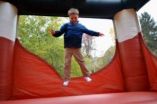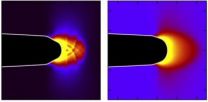(Press-News.org) COLUMBUS, Ohio – Doctors now use cancer-killing viruses to treat some patients with lethal, fast-growing brain tumors. Clinical trials show that these therapeutic viruses are safe but less effective than expected.
A new study led by researchers at the Ohio State University Comprehensive Cancer Center – Arthur G. James Cancer Hospital and Richard J. Solove Research Institute (OSUCCC – James) shows that the reason for this is in part due to the patient's own immune system, which quickly works to eliminate the anticancer virus.
The findings, published in the journal Nature Medicine, show that the body responds to the anticancer virus as it does to an infection. Within hours, specialized immune cells called natural killer (NK) cells move in to eliminate the therapeutic virus in the brain.
The researchers discovered that the NK cells attack the viruses when they express specific molecules on their surface called NKp30 and NKp46. "These receptor molecules enable the NK cells to recognize and destroy the anticancer viruses before the viruses can destroy the tumor," says co-senior author Dr. Michael A. Caligiuri, director of Ohio State's Comprehensive Cancer Center and CEO of the James Cancer Hospital and Solove Research Institute, and a senior author of the study.
"When we blocked those receptors, the virus has more time to work, and mice with these brain tumors live longer. The next step is to block these molecules on NK cells in glioblastoma patients and see if we can improve their outcome," says Caligiuri, who is also the John L. Marakas Nationwide Insurance Enterprise Foundation Chair in Cancer Research.
This study of cancer-cell-killing, or oncolytic, viruses is an example of the value of translational research, in which a problem observed during clinical trials is studied in the laboratory to devise a solution.
"In this case, clinical trials of oncolytic viruses proved safe for use in the brain, but we noticed substantial numbers of immune cells in brain tumors after treatment," says senior author and neurosurgeon Dr. E. Antonio Chiocca, who was professor and chair of neurological surgery while at Ohio State University.
"To understand this process, we went back to the laboratory and showed that NK cells rapidly infiltrate tumors in mice that have been treated with the therapeutic virus. These NK cells also signal other inflammatory cells to come in and destroy the cancer-killing virus in the tumor."
The study used an oncolytic herpes simplex virus, human glioblastoma tumor tissue and mouse models, one of which hosted both human glioblastoma cells and human NK cells. Key technical findings include:
Replication of the therapeutic virus in tumor cells in an animal model rapidly attracted subsets of NK cells to the tumor site;
NK cells in tumors activated other immune cells (i.e., macrophages and microglia) that have both antiviral and anticancer properties;
Depletion of NK cells improves the survival of tumor-bearing mice treated with the therapeutic virus;
NK cells that destroy virus-infected tumor cells express the NKp30 and NKp46 receptors molecules that recognize the virus.
"Once we identify the molecules on glioblastoma cells that these NK cell receptors bind with, we might be able to use them to identify patients who will be sensitive to this therapy," Caligiuri says.
###
Funding from the U.S. National Institutes of Health/NINDS (grant NS061811), NCI (grants CA069246, CA68458, CA98472, and the National Center for Research Resources (grant RR025753), an American Medical Association Foundation Seed Grant, the Dardinger Neuro-oncology Laboratory and Pelotonia supported this research.
Other researchers involved in this study were Christopher A. Alvarez-Breckenridge, Jianhua Yu, Richard Price1, Jeffrey Wojton, Jason Pradarelli, Hsiaoyin Mao, Min Wei, Yan Wang, Shun He, Jayson Hardcastle, Soledad A. Fernandez and Balveen Kaur of Ohio State; Sean E. Lawler, now at University of Leeds, U.K.; Eric Vivier of Université de la Méditerranée, Marseille, France; Ofer Mandelboim of Hebrew University-Hadassah Medical School, Jerusalem, Israel; Alessandro Moretta of Università degli Studi di Genova, Genova, Italy.
The Ohio State University Comprehensive Cancer Center – Arthur G. James Cancer Hospital and Richard J. Solove Research Institute strives to create a cancer-free world by integrating scientific research with excellence in education and patient-centered care, a strategy that leads to better methods of prevention, detection and treatment. Ohio State is one of only 41 National Cancer Institute (NCI)-designated Comprehensive Cancer Centers and one of only seven centers funded by the NCI to conduct both phase I and phase II clinical trials. The NCI recently rated Ohio State's cancer program as "exceptional," the highest rating given by NCI survey teams. As the cancer program's 228-bed adult patient-care component, The James is a "Top Hospital" as named by the Leapfrog Group and one of the top cancer hospitals in the nation as ranked by U.S.News & World Report.
(Philadelphia, PA) – A team of scientists from Temple University School of Medicine and the University of Pennsylvania has moved another step closer to solving a decades-long mystery of how the all-important flow of calcium into the cell's power source, the mitochondria, is controlled.
By painstakingly shutting down the activity of 50 genes, one at a time, they have identified a protein, MCUR1, which hugs the inside of the mitochondrial membrane and is part of an elaborate mitochondrial channel pore system. MCUR1 acts as an accelerator to help regulate calcium coming ...
CHICAGO – People with Parkinson's disease benefit from exercise programs on stationary bicycles, with the greatest effect for those who pedal faster, according to a study presented today at the annual meeting of the Radiological Society of North America (RSNA). Functional connectivity magnetic resonance imaging (fcMRI) data showed that faster pedaling led to greater connectivity in brain areas associated with motor ability.
Parkinson's disease is a chronic, progressive disorder of the central nervous system. Early-stage symptoms like shaking and difficulty with walking ...
CHICAGO – Both very high and very low levels of physical activity can accelerate the degeneration of knee cartilage in middle-aged adults, according to a new study presented at the annual meeting of the Radiological Society of North America (RSNA).
Nearly one in every two people in the U.S. may develop knee osteoarthritis by age 85, according to the Centers for Disease Control and Prevention. By 2030, an estimated 67 million Americans over the age of 18 are projected to have physician-diagnosed arthritis.
Researchers at the University of California in San Francisco ...
CHICAGO – An active lifestyle helps preserve gray matter in the brains of older adults and could reduce the burden of dementia and Alzheimer's disease (AD), according to a study presented today at the annual meeting of the Radiological Society of North America (RSNA).
Dementia exacts a staggering toll on society. More than 35 million people worldwide are living with the disease, according to the World Health Organization, and the prevalence is expected to double by 2030. AD is the most common cause of dementia and currently has no cure.
Cyrus Raji, M.D., Ph.D., radiology ...
CHICAGO – Using a special magnetic resonance imaging (MRI) technique to image patients with mild traumatic brain injury (MTBI), researchers have identified a biomarker that may predict which patients will do well over the long term, according to a study presented today at the annual meeting of the Radiological Society of North America (RSNA).
The results of the study showed that in some patients the brain may have changed to compensate for the damage caused by the injury.
"This finding has huge potential implications for preventing and repairing the damage that accompanies ...
CHICAGO – All patients with Alzheimer's disease (AD) lose brain cells, which leads to a shrinking, or atrophy, of the brain. But the pattern of gray matter loss is significantly different in men and women, according to a study presented today at the annual meeting of the Radiological Society of North America (RSNA).
"We found that the extent and distribution of regional gray matter volume loss in the brain was strongly influenced by gender," said lead researcher Maria Vittoria Spampinato, M.D., associate professor of radiology at the Medical University of South Carolina ...
VIDEO:
Inflatable bouncers such as bounce houses, slides or obstacle courses are the new craze for kids' birthday parties and/or celebrations. While they appear to be a fun activity for a...
Click here for more information.
A new study by researchers at the Center for Injury Research and Policy of The Research Institute at Nationwide Children's Hospital examined pediatric injuries associated with inflatable bouncers, such as bounce houses and moonwalks. Researchers found ...
November 26, 2012 – (BRONX, NY) – Researchers at Albert Einstein College of Medicine of Yeshiva University and Montefiore Medical Center have found that a special magnetic resonance imaging (MRI) technique may be able to predict which patients who have experienced concussions will improve. The results, which were presented today at the annual meeting of the Radiological Society of North America (RSNA), suggest that, in some patients, the brain may change to compensate for the damage caused by the injury.
"This finding could lead to strategies for preventing and repairing ...
Metallic glass alloys (or liquid metals) are three times stronger than the best industrial steel, but can be molded into complex shapes with the same ease as plastic. These materials are highly resistant to scratching, denting, shattering and corrosion. So far, they have been used in a variety of products from golf clubs to aircraft components. And, some smartphone manufacturers are even looking to cast their next-generation phone cases out of it.
But despite their potential, the mechanical properties of these substances are still a scientific mystery. One lingering question ...
PULLMAN, Wash.—Scientists and business people have known for decades that certain scents—pine boughs at Christmas, baked cookies in a house for sale—can get customers in the buying spirit. Eric Spangenberg, a pioneer in the field and dean of the Washington State University College of Business, has been homing in on just what makes the most commercially inspiring odor.
Spangenberg and colleagues at WSU and in Switzerland recently found that a simple scent works best.
Writing in the Journal of Retailing, the researchers describe exposing hundreds of Swiss shoppers to simple ...

